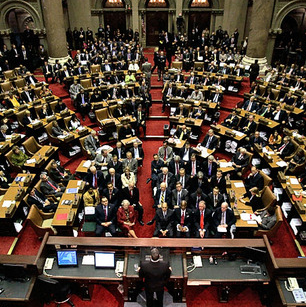State Policy
PCDC supports policies at the federal, state, and local level that promote health equity by expanding and ensuring access to quality primary care.
PCDC supports policies at the federal, state, and local level that promote health equity by expanding and ensuring access to quality primary care.

New for 2025 is NYS Senate Bill 1634/NY Assembly Bill 1915A. Learn more about how this proposed legislation can transform New York communities and achieve health equity by investing in primary care. Read more about why investing in primary care supports the health of low-income communities.
PCDC was created with a specific purpose: to finance New York health facilities and bring culturally competent, high-quality care to underserved communities. Today PCDC applies its expertise nationally, but New York State remains home – PCDC has worked with health care organizations, systems, and providers across the state on over 3,200 financing and technical assistance projects to build, strengthen, and expand primary care operations and services. With support from the New York State Legislature, we have financed and enhanced health care facilities and practices in the vast majority of New York State Senate and Assembly Districts to increase and improve the delivery of primary care and other vital health services for millions of New Yorkers. PCDC advocates for policies in New York State that will continue to improve access to quality primary care for all New York State residents.
PCDC also engages in advocacy with policymakers in New York State to expand access to high quality primary care for New Yorkers. Primary care saves lives, leads to individual health and community health, is unequivocally central to health equity, and reduces overall health care costs. “Primary care is the heart of a high-functioning health care system” and all New Yorkers deserve access to affordable, accessible, equitable primary care in their communities.
New York faces a primary care crisis. As of September 30, 2022, almost 6.5 million New Yorkers live in HRSA-designated primary care Health Professional Shortage Areas. New York’s per-person health care costs are higher than the national average, yet the state consistently ranks below many states in key health indicators such as low birth weight, preventable hospitalizations, and childhood immunizations. Moreover, the COVID-19 pandemic underscored and exacerbated existing health care disparities. People living in historically disinvested communities, people of color and low-income people had less access to primary care even before the pandemic, and experienced both more COVID infections and greater COVID-related mortality and morbidity. Further, by 2033, the national primary care physician supply is projected to fall short of demand by as much as 55,000 providers, and in New York State, there will likely be a compounded situation where new shortages develop and existing shortages are exacerbated.
Confronting this crisis and expanding access to quality primary care in New York State is the best way to address health disparities, improve population health, and move towards health equity.
PCDC’s Director of Policy, Jordan Goldberg, and Director of Research and Evaluation, Anna Popinchalk, joined with David Lombardo, host of The Capitol Pressroom, to highlight the limited access to primary care services in parts of New York and identify policies that would boost access. Listen to the podcast.
High-quality, integrated, patient-centered primary care saves lives, leads to better individual and community health, and is central to health equity. Primary care is the foundation of our health care system and is key to prevention, early diagnosis, and treatment. State-level policymakers have a significant role to play in strengthening and supporting this kind of quality primary care through legislation and regulations. PCDC urges policymakers at the state level across the country to understand the value of primary care and put forward policy solutions to achieve better access to high-quality primary care for their communities.
Read PCDC’s 2022 report on major state-level primary care trends.
Read PCDC’s update on major state-level primary care trends for the 2023 legislative session.